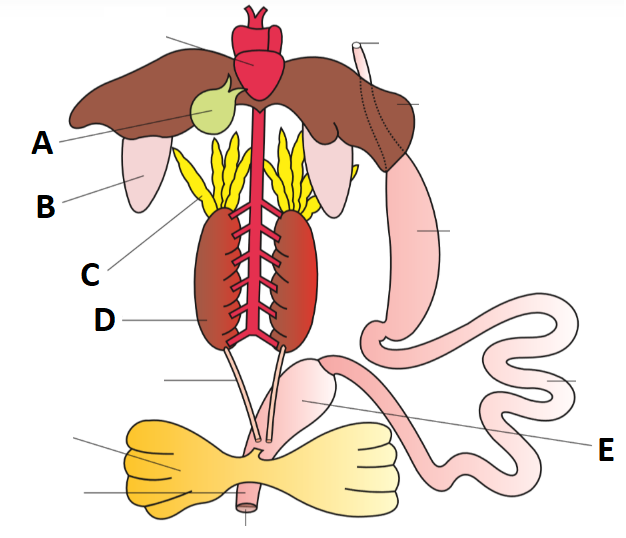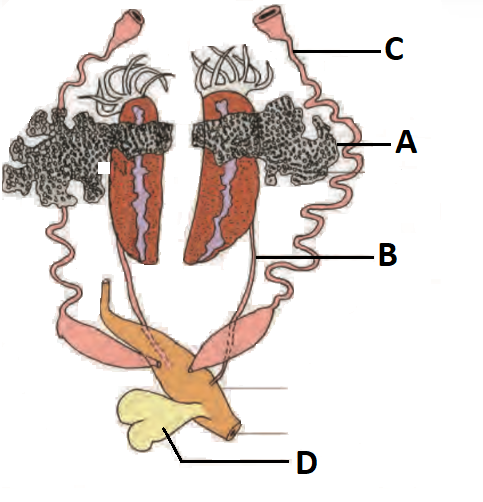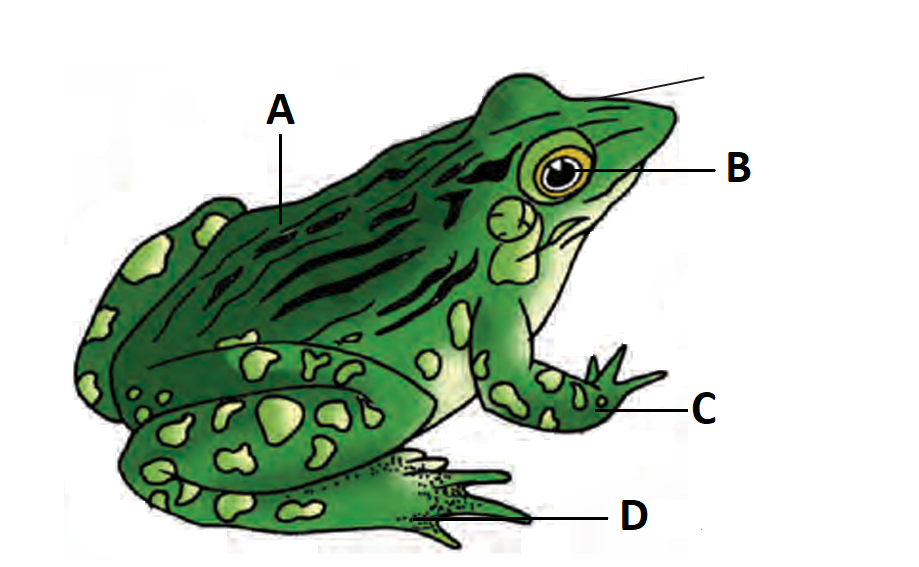Structural Organisation in Animals NCERT
Quiz Summary
0 of 45 Questions completed
Questions:
Information
You have already completed the quiz before. Hence you can not start it again.
Quiz is loading…
You must sign in or sign up to start the quiz.
You must first complete the following:
Results
Results
0 of 45 Questions answered correctly
Your time:
Time has elapsed
You have reached 0 of 0 point(s), (0)
Earned Point(s): 0 of 0, (0)
0 Essay(s) Pending (Possible Point(s): 0)
Categories
- Not categorized 0%
- 1
- 2
- 3
- 4
- 5
- 6
- 7
- 8
- 9
- 10
- 11
- 12
- 13
- 14
- 15
- 16
- 17
- 18
- 19
- 20
- 21
- 22
- 23
- 24
- 25
- 26
- 27
- 28
- 29
- 30
- 31
- 32
- 33
- 34
- 35
- 36
- 37
- 38
- 39
- 40
- 41
- 42
- 43
- 44
- 45
- Current
- Review
- Answered
- Correct
- Incorrect
-
Question 1 of 45
1. Question
1 point(s)The above figure is associated with diagrammatic representation of internal organs of frog. Identify A to E:

\(
\begin{array}{|c|c|c|c|c|c|}
\hline
\ & A & B & C & D & E \\ \hline
1 & \text{Gall bladder} & \text{Lung} & \text{Ovary} & \text{Testis} & \text{Rectum} \\ \hline
2 & \text{Gall bladder} & \text{Lung} & \text{Fat bodies} & \text{Testis} & \text{Rectum} \\ \hline
3 & \text{Gall bladder} & \text{Lung} & \text{Testis} & \text{Kidney} & \text{Rectum} \\ \hline
4 & \text{Gall bladder} & \text{Lung} & \text{Fat bodies} & \text{Kidney} & \text{Rectum} \\ \hline
\end{array}
\)CorrectIncorrectHint
(d)
-
Question 2 of 45
2. Question
1 point(s)Bull frog of India is:-
CorrectIncorrectHint
(a)
-
Question 3 of 45
3. Question
1 point(s)Frogs belonging to class _____ of phylum chordata are _____ animals and show hibernation ____ and aestivation in ___________?
CorrectIncorrectHint
(c)
-
Question 4 of 45
4. Question
1 point(s)The frogs have the ability to change the colour to hide them from enemies . This protective coloration called:-
CorrectIncorrectHint
(a)
-
Question 5 of 45
5. Question
1 point(s)The body of frog is divisible into:-
CorrectIncorrectHint
(a)
Body of a frog is divisible into head and trunk. A neck and tail are absent.
-
Question 6 of 45
6. Question
1 point(s)Which of the following is false about the frog?
I. Eyes are bulged out and covered by a nictitating membrane that protects them while in water
II. On either side of the eyes a membranous tympanum (ear) receives sound signals
III. The forelimbs and hind limbs help in swimming, walking, leaping and burrowing
IV. The hind limbs end in five digits and they are larger and muscular than fore limbs that end in four digits
V. Feet have webbed digits that help in swimming.
VI. Frogs exhibit sexual dimorphism.CorrectIncorrectHint
(d)
All are correct
-
Question 7 of 45
7. Question
1 point(s)Go through the following figure indicating the male reproductive system of frog. Identify A to D

\(
\begin{array}{|c|c|c|c|c|}
\hline
\ & A & B & C & D \\ \hline
1 & \text{Bidder’s canal} & \text{Adrenal gland} & \text{Urinogenital duct} & \text{Rectum} \\ \hline
2 & \text{Bidder’s canal} & \text{Adrenal gland} & \text{Urinogenital duct} & \text{Cloaca} \\ \hline
3 & \text{Vasa efferentia} & \text{Adrenal gland} & \text{Urinogenital duct} & \text{Cloaca} \\ \hline
4 & \text{Vasa efferentia} & \text{Thyroid gland} & \text{Urinogenital duct} & \text{Cloaca} \\ \hline
\end{array}
\)CorrectIncorrectHint
(c)
-
Question 8 of 45
8. Question
1 point(s)Match the following columns w.r.t. frog
\(
\begin{array}{|l|l|}
\hline \begin{array}{l}
\text { COLUMN I } \\
\end{array} & \begin{array}{l}
\text { COLUMN II } \\
\end{array} \\
\hline \text { (a). Foramen magnum } & \text { (i). Hindbrain } \\
\hline \text { (b). Olfactory lobes } & \text { (ii). Forebrain } \\
\hline \text { (c). Optic lobes } & \text { (iii). Skull } \\
\hline \text { (d). Cerebellum } & \text { (iv). Midbrain } \\
\hline
\end{array}
\)CorrectIncorrectHint
(c)
-
Question 9 of 45
9. Question
1 point(s)Cloaca in an adult female frog receives the opening(s) of
CorrectIncorrectHint
(d)
-
Question 10 of 45
10. Question
1 point(s)Which of the following statements is incorrect w.r.t. frog?
CorrectIncorrectHint
(d)
Nuptial pads appear on the male frog’s forelimbs (thumb/prepollex region), not hind limbs. These pads are androgen-stimulated mucous gland swellings that help males grip the female during amplexu
-
Question 11 of 45
11. Question
1 point(s)Consider the given statements w.r.t. frog
(a) Fertilisation is external and takes place in water
(b) Tadpole larva has tail
(c) Frog can balance the food chain and food web
(d) In some countries, the muscular legs of frog are used as food by man
Which of the above statement is/are correct?CorrectIncorrectHint
(d)
-
Question 12 of 45
12. Question
1 point(s)Find the correct statement w.r.t. frog?
CorrectIncorrectHint
(d)
a.❌ Incorrect. Frogs lack a typical external ear; instead, they have a tympanic membrane (tympanum) on the surface, whereas the round window is an internal feature in the middle ear
b.❌ Incorrect. While frogs use both skin (cutaneous) and lung respiration under normal conditions, during hibernation they rely almost exclusively on cutaneous respiration, since metabolic activity is very low and lungs are largely inactive
c.❌ Incorrect. Frogs do exhibit sexual dimorphism. Males have vocal sacs and nuptial pads on their forelimbs—features females lack
-
Question 13 of 45
13. Question
1 point(s)Both male and female frogs have:-
CorrectIncorrectHint
(c)
-
Question 14 of 45
14. Question
1 point(s)Select the incorrect statement w.r.t. frogs.
CorrectIncorrectHint
(a)
Frog lymph does contain proteins, though in smaller amounts than blood, and also includes white blood cells (but lacks red blood cells) .So saying blood cells are present but proteins are absent is false.
-
Question 15 of 45
15. Question
1 point(s)One of the main function of frog’s skin is:-
CorrectIncorrectHint
(a)
-
Question 16 of 45
16. Question
1 point(s)The structure present in man but absent in frog is:-
CorrectIncorrectHint
(b)
The structure present in humans but absent in frogs is the salivary glands. Unlike humans—who possess three paired salivary glands (parotid, submandibular, and sublingual)—frogs lack these specialized exocrine glands entirely
-
Question 17 of 45
17. Question
1 point(s)Which of the following is absent in vascular system of frog?
CorrectIncorrectHint
(a)
-
Frog red blood cells (RBCs) are nucleated, meaning they contain a nucleus. Enucleated RBCs (without nuclei) are characteristic of mammals, not amphibians like frogs.
-
Therefore, enucleated RBCs are absent in the frog’s vascular system.
-
Question 18 of 45
18. Question
1 point(s)In frog, digestion of fats occurs mostly in:
CorrectIncorrectHint
(d)
-
Question 19 of 45
19. Question
1 point(s)Male frog can be distinguished from female frog by the presence of:
CorrectIncorrectHint
(d)
-
Question 20 of 45
20. Question
1 point(s)The adult frog is:-
CorrectIncorrectHint
(b)
-
Question 21 of 45
21. Question
1 point(s)The above figure is related with female reproductive system of frog. Identify A to D

\(
\begin{array}{|c|c|c|c|c|}
\hline
\ & A & B & C & D \\ \hline
1 & \text{Ovary} & \text{Ureter} & \text{Oviduct} & \text{Urinary Bladder} \\ \hline
2 & \text{Ovary} & \text{Oviduct} & \text{Ureter} & \text{Cloaca} \\ \hline
3 & \text{Ovary} & \text{Urinary Bladder} & \text{Urinogenital duct} & \text{Ureter} \\ \hline
4 & \text{Ovary} & \text{Oviduct} & \text{Ureter} & \text{Urinary Bladder} \\ \hline
\end{array}
\)CorrectIncorrectHint
(a)
-
Question 22 of 45
22. Question
1 point(s)In frog, food is captured by:-
CorrectIncorrectHint
(b)
-
Question 23 of 45
23. Question
1 point(s)Heart of frog differs from that of man by the presence of:-
CorrectIncorrectHint
(c)
-
Question 24 of 45
24. Question
1 point(s)Choose the correct statement w.r.t. frog
CorrectIncorrectHint
(d)
-
Question 25 of 45
25. Question
1 point(s)In frog, undigested solid wastes pass out through:-
CorrectIncorrectHint
(b)
-
Question 26 of 45
26. Question
1 point(s)Which of the following is false about the respiration of frog?
CorrectIncorrectHint
(a)
-
In water, frogs rely entirely on cutaneous respiration, where oxygen diffuses through the skin—a method suited for aquatic environments.
-
On land, they employ multiple methods: lungs (via buccal pumping), skin, and even the lining of the buccal cavity (mouth) . These are distinct from the cutaneous-only method used underwater.
-
Question 27 of 45
27. Question
1 point(s)In frog, ventricle opens into ________ on the ________ side of heart-
CorrectIncorrectHint
(c)
-
Question 28 of 45
28. Question
1 point(s)In frog, which one of the following opens into the duodenum?
CorrectIncorrectHint
(d)
In frogs, both bile from the gall bladder and pancreatic juice from the pancreas are transported through a common duct known as the hepatopancreatic duct. This duct opens directly into the duodenum (the initial segment of the small intestine)
- The pancreatic duct alone carries only pancreatic enzymes.
- The bile duct conducts bile independently.
- The hepatic duct serves solely to drain bile from the liver to the gall bladder or bile duct.
- Only the hepatopancreatic duct combines these secretions before entering the duodenum.
-
Question 29 of 45
29. Question
1 point(s)In frog, a triangular structure called _____ joins the right ______ .
CorrectIncorrectHint
(c)
-
Question 30 of 45
30. Question
1 point(s)Identify A, B, C and D respectively:
 CorrectIncorrect
CorrectIncorrectHint
(d)
-
Question 31 of 45
31. Question
1 point(s)In frog, which of the following receives blood through vena cava ?
CorrectIncorrectHint
(a)
-
In frogs, the vena cavae (both anterior and posterior) drain directly into the sinus venosus—a thin-walled, triangular chamber situated on the dorsal side of the heart
-
From the sinus venosus, blood flows into the right auricle, continues into the ventricle, and then is pumped onwards
-
Question 32 of 45
32. Question
1 point(s)Which of the following special venous system is present in frog?
CorrectIncorrectHint
(c)
-
Question 33 of 45
33. Question
1 point(s)In frog, lymphatic system consists of:-
CorrectIncorrectHint
(d)
-
Question 34 of 45
34. Question
1 point(s)In frog, the excretory system consists of –
CorrectIncorrectHint
(c)
-
Question 35 of 45
35. Question
1 point(s)In frog, urinary bladder is:-
CorrectIncorrectHint
(c)
-
Question 36 of 45
36. Question
1 point(s)In frog, the ureter acts as urinogenital duct in –
CorrectIncorrectHint
(a)
-
Question 37 of 45
37. Question
1 point(s)The medulla oblongata passes out through –
CorrectIncorrectHint
(a)
-
Question 38 of 45
38. Question
1 point(s)Which one is correct about the respiration of frog?
I. In frog , cutaneous and pulmonary respiration are found
II. A pair of elongated pink hollow lungs are found in thorax
III. \( \text { Atmospheric } \mathrm{O}_2 \longrightarrow \text { Nostril } \longrightarrow \text { Buccal cavity } \longrightarrow \text { Lungs } \)
IV. During aestivation and hibernation, gaseous exchange takes place through skinCorrectIncorrectHint
(a)
All are correct
-
Question 39 of 45
39. Question
1 point(s)Which of the following is incorrect about the portal venous system?
CorrectIncorrectHint
(b)
Option (b) is false; the hepatic vein does not connect liver lobes in a portal system but instead drains blood out to the IVC
-
Question 40 of 45
40. Question
1 point(s)Which of the following is false?
CorrectIncorrectHint
(d)
Development in frog is direct.
❌ Incorrect—for most frog species, development is indirect, not direct -
Question 41 of 45
41. Question
1 point(s)Which of the following is false about the nervous system of frog?
CorrectIncorrectHint
(a)
NCERT: Forebrain includes olfactory
lobes, paired cerebral hemispheres and unpaired
diencephalon -
Question 42 of 45
42. Question
1 point(s)Frog has sense organs like sensory papillae (for touch), taste buds, nasal epithelium (smell), eyes, tympanum with internal ear (for hearing) out of these, which of the following is well-organised structure?
CorrectIncorrectHint
(a)
-
Question 43 of 45
43. Question
1 point(s)In frog , cutaneous respiration occurs
CorrectIncorrectHint
(a)
-
Question 44 of 45
44. Question
1 point(s)Which of the following sequences is correct for the passage of sperms in frog (male) ?
CorrectIncorrectHint
(b)
-
Question 45 of 45
45. Question
1 point(s)Which of the following is the use of frog?
CorrectIncorrectHint
(d)